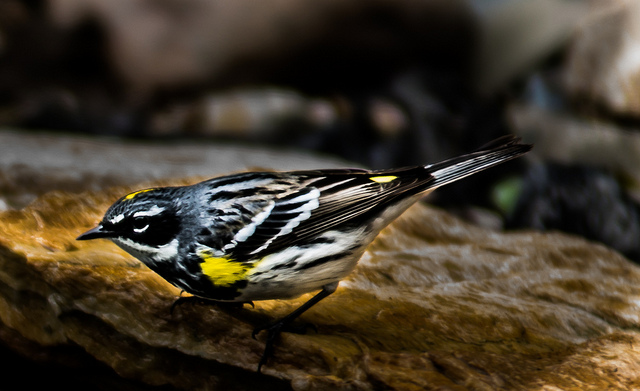Last week at the public library in Evansville, Indiana, more than 125 people gathered for a program about building backyard bird habitats, complete with hundreds of photos of warblers and other songbirds, all taken in the presenter’s own yard. She emphasized the need for local and migratory birds to find water, food, and shelter at a time of growing sparseness. The program was sponsored by Tri-State Creation Care and Hoosier Interfaith Power & Light, a coalition of people of all faiths dedicated to healing the ruptures humans have created in the environment.
The next morning, hundreds of others gathered at the Indianapolis statehouse 172 miles away to speak against a bill in the Senate Utilities Committee, written by the state’s for-profit utilities, that would destroy Indiana’s small but growing customer-owned renewable energy efforts. With standing-room-only and overflow into the hallways, dozens testified against the bill, citing the importance of the solar panels their families and congregations had invested in, the urgency of building renewable energy, and the lack of credibility of the claims the utilities were making against it. A couple of dozen school superintendents from across the state testified to the savings for education that would be lost if the several million dollars they were saving by generating power were sacrificed to the utilities’ pockets. People of all faiths testified to their responsibility to protect God’s creation by reducing their carbon footprint.
What a contrast — one meeting in a free public library relishing aesthetically, the other in the halls of governmental power fighting politically. The common thread was defending what we love.
In a programming meeting a few evenings later, five environmental advocates from five different cities and three faiths — Muslim, Unitarian, and Presbyterian — preceded their discussion of hard work by reflecting on the things keeping us going. Two had been tapping their maple trees and making syrup in the Indiana cold. One reported on a meal of fresh spinach salad picked from a homemade cold frame the day before, along with quiche made from zucchini shredded and frozen last summer. We were there, late in the evening, making work for ourselves, because one another’s encouragement kept us hopeful.
What we love, we protect: grandchildren that we hope will enjoy the quality of life we have known; lone patches of old growth forest reminding us of time and dignity; churches conserving resources by reducing power; sandhill cranes calling as they migrate overhead, the mighty river ceaselessly flowing beneath bridges, mirroring their colored lights and the red-blue sky of dusk.
“Everybody needs a climate thing,” explained columnist David Roberts in 2015. His brilliant article concludes with these words about the things we love:
Climate is everything, which means everyone touches only a tiny piece of it. Let people care about their birds or their pipelines or their mountains or their tech startups or their research clusters or their permaculture farms. Everybody needs a Climate Thing, a close-by proxy through which they can express their climate concern in a way that has local effects and tangible rewards. It is these proxies, these rich anchors in our lived experience of nature and culture, that inspire us.
March and April 2017 encompass Lent and Easter, and immediately after, Earth Day weekend and Earth Week. Many churches jam their environmental emphases into those days, but if the earth supports us year-round, why not gratefully protect it and its inhabitants year round?
March 5 (First Sunday in Lent)
- Genesis 2:15-17; 3:1-7 describes God’s forming of the human (adam) from the ground (adamah) — a thematic word repeated 14 times in Genesis 2-4. According to the Eden story, everything vital comes from the ground, which the humans were instructed to serve and preserve. See more here.
- Psalm 32 and Matthew 4:1-11 relate wilderness experiences of sin and temptation.
March 12 (Second Sunday in Lent)
- Genesis 12:1-4a conveys God’s speech to Abraham about the land where God would bless his family.
- Psalm 121 describes the maker of heaven and earth as our protector.
- John 3:1-17 characterizes the God as not condemning but saving the world.
March 19 (Third Sunday in Lent)
- Exodus 17:1-7 narrates God’s producing water in the desert for thirsty Israelites.
- Psalm 95 proclaims, “In God’s hand are the depths of the earth; the heights of the mountains are God’s also” and calls humans “the people of God’s pasture.”
- Romans 5:1-11 encourages persistence, which produces character and hope.
- John 4:5-42 reflects on well water, nourishment, and ripening fields.
March 26 (Fourth Sunday in Lent)
- Psalm 23, in vivid imagery of pastures and streams, points out the parallels between humans tended by God and sheep tended by their shepherds.
- John 9:1-41 narrates the miracle of sight given through the humble medium of mud.
April 2 (Fifth Sunday in Lent)
- Ezekiel 37:1-14 offers hope of resurrection for a dying community through one who prophesies new life.
- Psalm 130 presents a long view of the future and forgiveness for past mistakes.
- Romans 8:6-11 can easily be misunderstood as discounting earthly life. But the chapter goes on to say that creation itself awaits redemption.
- John 11:1-45 describes Jesus as a savior who brings new life.
April 9 (Palm Sunday)
- Psalm 118:1-2, 19-29 (Liturgy of the Palms) uses elements of the natural world — stones and tree branches — to describe rejoicing.
- Philippians 2:5-11 (Liturgy of the Passion) describes the humility and self-emptying work of Christ.
- Matthew 26:14-27:66 (Liturgy of the Passion) brings a common meal, common foods of wine and bread, a garden, and a farmyard rooster into the story of Jesus’ passion.
- Matthew 27:11-54 (Liturgy of the Passion alternate) binds human sin to responses in the natural world by describing an earthquake occurring as Jesus wrongfully died.
April 16 (Easter Sunday)
- Acts 10:34-43 tells how Peter began to accept, and to preach, a more inclusive, worldwide gospel of Jesus Christ.
- Jeremiah 31:1-6 (alternate) uses the resumption of planting and harvest as signs of a rebuilt, healthy, and prosperous community.
- Colossians 3:1-4 challenges us to distinguish between God’s good creation and the sinful order Paul often identifies as “earthly.”
- John 20:1-18 relates Mary being more right than she may have known when she supposed Jesus to be the gardener.
- Matthew 28:1-10 (alternate) announces Jesus’ resurrection with an earthquake.
April 23 (Second Sunday of Easter)
- Psalm 16 rejoices in divine protection, expressed as “boundary lines in pleasant places” and “a goodly heritage.”
- 1 Peter 1:3-9 counsels patience through various trials that refine believers as gold is refined.
- John 20:19-31 offers hope and peace in the midst of doubt.
April 30 (Third Sunday of Easter)
- 1 Peter 1:17-23 says, “You have been born anew, not of perishable but of imperishable seed, through the living and enduring word of God.”
- Luke 24:13-35 shows Jesus revealed to two disciples as they break bread together.
- Psalm 116:1-4, 12-19 reinforces gratitude for the blessings of earth, asking, “What shall I return to the LORD for all God’s bounty to me?”
Indeed, what shall we return for the glorious world we are blessed to inhabit?
Patricia Tull’s bimonthly Working Preacher column, “The Great Community,” focuses on ecological themes for preaching.

